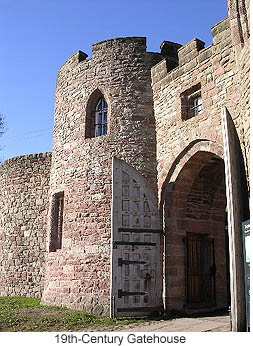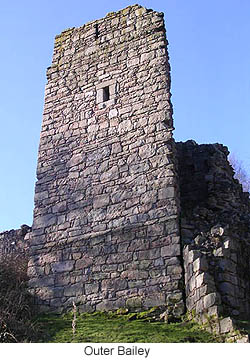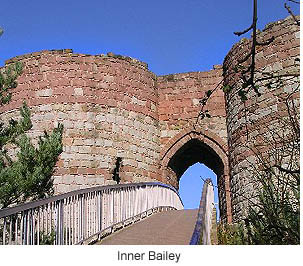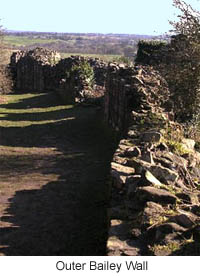Beeston: Castle of the Rock
by Julia Hickey
 The so called "Castle of the Rock" in the little village of Beeston a few miles east of Chester was inspired by the crusader castles of the Holy Land. Set on a windswept crag, 350 feet above rolling plains, it has a view of eight counties on a clear day.
The so called "Castle of the Rock" in the little village of Beeston a few miles east of Chester was inspired by the crusader castles of the Holy Land. Set on a windswept crag, 350 feet above rolling plains, it has a view of eight counties on a clear day.
The ruins that remain are part of a story that stretches back 4000 years. Sadly the castle walls are not very extensive. This is testimony to the strength with which it withstood siege during the civil war. It is not a surprise that the parliamentarian forces made an effective job of sleighting the stronghold when the castle eventually fell into their hands. Enough remains though to make Beeston worth a stop for castle enthusiasts. Wrap up well and wear sturdy shoes.
A little museum housed in a modern extension of the nineteenth century gatehouse at the bottom of the hill retells the castle's story through a display of models based on archaeological surveys and also a selection of artefacts including flint arrow heads dating from the Neolithic period; bronze age axe heads; funeral urns; loom weights and lead shot dating from the end of the castle's active life.
The castle was originally begun by Ranulf, Earl of Chester who returning from the Holy Land in 1220 began work on his "castle of the rock". The inner bailey is situated on the rocky summit; a huge defensive ditch can still be seen; the portcullis and the D shaped towers of the narrow gateway designed to allow defenders an opportunity to sweep their hail of arrows across the walls rather than just forwards as had been the case in earlier castles.
 The outer bailey is huge. The stout walls, part of which can still be seen, also contain a number of further D shaped towers which at that time were at the forefront of fighting technology. The gatehouse leading into the outer bailey was torn down during the eighteenth century to allow a track way to be built for the quarrymen to remove the stones from the site but enough of it stands to show how imposing it must once have been. Archaeologists have also revealed that the site of the outer bailey walls was chosen on account of the fortifications remaining from an earlier Iron Age rampart.
The outer bailey is huge. The stout walls, part of which can still be seen, also contain a number of further D shaped towers which at that time were at the forefront of fighting technology. The gatehouse leading into the outer bailey was torn down during the eighteenth century to allow a track way to be built for the quarrymen to remove the stones from the site but enough of it stands to show how imposing it must once have been. Archaeologists have also revealed that the site of the outer bailey walls was chosen on account of the fortifications remaining from an earlier Iron Age rampart.
When Ranulf died, twelve years after building first commenced, the castle at Beeston remained unfinished. Permanent stone dwellings were never completed because when Ranulf's heir died five years later the earldom and the castle at Beeston fell into the hands of Henry III who had plans for the well built fortifications. He used the site as a base to wage war upon the Welsh. Beeston became a depot for a field army rather than a permanent stronghold. Looking at the scale of the outer bailey it is easy to imagine wooden buildings and tents pitched in the shelter of the walls filled with men waiting to march into Wales. Later when Wales was defeated and a ring of castles built to keep the Welsh enslaved many of the castles displayed the D-shaped gatehouse towers that marked Beeston as different from anything that had come before.
The castle was kept in good repair for the duration of the Welsh wars but by the middle of the fourteenth century the kings of England had no further need for the fortification so it was sold to a local knight -- Sir Hugh Beeston.
 The history of the castle took a dramatic turn when Charles I raised his standard at Nottingham Castle in 1642 and England was thrown into a bloody civil war. Ranulf's D-shaped towers; his imposing walls; the rocky cliffs and commanding view were immediately recognised as having strategic importance: especially as the nearby town of Chester was held for the King and the port was used to land Irish troops. The Parliamentarians immediately seized the site and made good the decay of time before garrisoning the castle with sixty men.
The history of the castle took a dramatic turn when Charles I raised his standard at Nottingham Castle in 1642 and England was thrown into a bloody civil war. Ranulf's D-shaped towers; his imposing walls; the rocky cliffs and commanding view were immediately recognised as having strategic importance: especially as the nearby town of Chester was held for the King and the port was used to land Irish troops. The Parliamentarians immediately seized the site and made good the decay of time before garrisoning the castle with sixty men.
Unfortunately they had not accounted for audacity or treachery. Eight Royalists scaled the imposing cliff face to the inner bailey and somehow gained the upper hand. From the moment that the Royalist flag fluttered above the parapet Beeston's fate was sealed. The garrison was placed under siege which it withstood for a year. Eventually it was starvation rather than gunfire that forced the soldiers out through Beeston's gates in November 1645. They left with their heads held high because their commander was able to negotiate favourable terms for their surrender. Only when the Parliamentarians entered the grounds of the castle and found that there was no food did they realise how close they had been to complete victory. The walls were toppled and the castle rendered indefensible.
Eventually the site became a quarry. One of the walks through the outer bailey takes visitors to the caves created by the quarrymen but by 1846 the castle ruins had become a tourist attraction.
 There is something very romantic in the climb up the wooded hill along the sunken path created by the wheels of quarry wagons. The outer bailey appears out of nowhere and it is almost possible to believe that it has remained undiscovered for hundreds of years. As the climb continues and visitors cross the narrow bridge into the inner bailey it is also almost possible to believe that Richard II's treasure still remains hidden somewhere on the site. The story is that Richard hid his gold at Beeston during his journey to Chester where he boarded a ship to Ireland to quell a rebellion. On his return Richard was deposed by Henry, Duke of Lancaster, who became Henry IV. The treasure is supposed to have remained undiscovered since that time. Over the years many searches have been made most of them focused on the deep well -- one of the deepest in England -- in the inner bailey. But it is only a story. Henry IV is recorded to have recovered the gold and jewellery that constituted Richard's treasure from its various hiding places. There is something very romantic in the climb up the wooded hill along the sunken path created by the wheels of quarry wagons. The outer bailey appears out of nowhere and it is almost possible to believe that it has remained undiscovered for hundreds of years. As the climb continues and visitors cross the narrow bridge into the inner bailey it is also almost possible to believe that Richard II's treasure still remains hidden somewhere on the site. The story is that Richard hid his gold at Beeston during his journey to Chester where he boarded a ship to Ireland to quell a rebellion. On his return Richard was deposed by Henry, Duke of Lancaster, who became Henry IV. The treasure is supposed to have remained undiscovered since that time. Over the years many searches have been made most of them focused on the deep well -- one of the deepest in England -- in the inner bailey. But it is only a story. Henry IV is recorded to have recovered the gold and jewellery that constituted Richard's treasure from its various hiding places.
The real treasure at Beeston is the site itself. Welsh mountains, the Pennines and the Peak District can all be seen over the remains of the castle walls or through the arrow slits that were carefully widened to allow musketeers to make use of the different vantage points. And nearer at hand there are beautiful woodlands and clearings in the outer bailey filled with the sound of birdsong. If visitors are lucky it can feel as if they are all alone in this historic place.
More Information:
We regret that we no longer have the resources to maintain up-to-date links and/or hours and pricing details for the various sites and attractions listed on this website. For more information about the location(s) listed above, please use your favorite search engine or visit Wikipedia.
Julia Hickey is passionate about England's heritage and particularly of Cumbria, where her husband comes from. In between dragging her family around the country to a variety of historic monuments, she works part-time as a senior lecturer at Sheffield Hallam University. She spends the rest of her week writing. In her spare time, she enjoys walking, dabbling in family history, cross-stitch, tapestry and photography.
Article & photos © 2005 Julia Hickey
| 